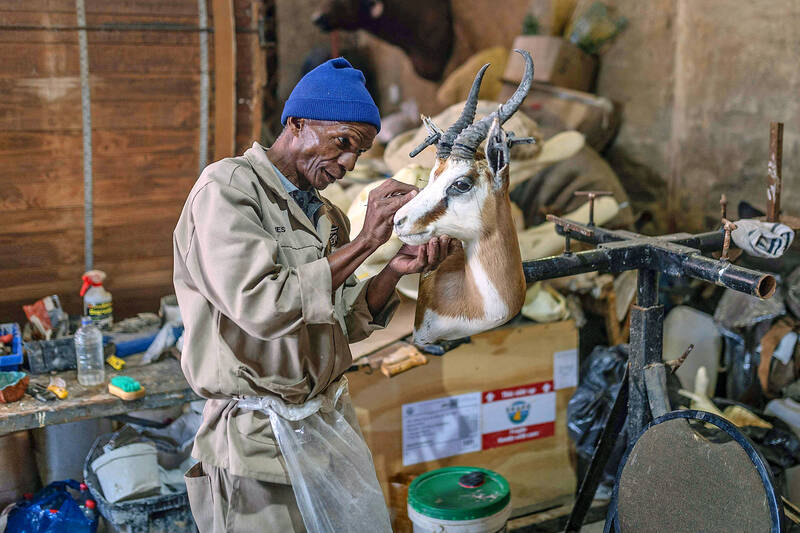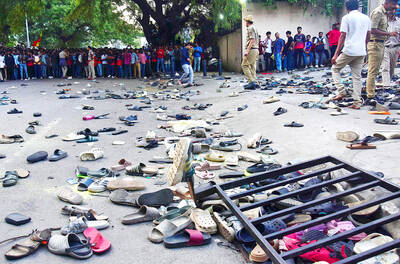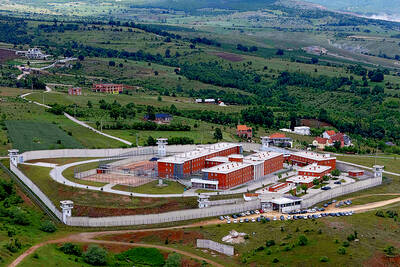Workers in Pieter Swart’s tanning and taxidermy workshop are busy skinning impala heads, bleaching buffalo bones and softening zebra skins.
His business in South Africa has thrived for years, but it is now threatened by a British law sponsored by animal activists, the 58-year-old said.
Swart worries that the bill, which bans the import of hunting trophies, could open the way for a deluge of similar legislation.

Photo: AFP
It would scupper demand for the centuries-old craft of stuffing hunters’ quarry for display, leading to painful job losses in top international hunting destinations in southern Africa, he said.
“We are very much concerned. The law could create a domino effect,” said Swart, a zebra skull sitting on his desk.
The British legislation, which aims to help protect endangered animals, was approved by British lawmakers in March.
Covering thousands of species, including lions, rhino and elephants, it reflects a broader shift in Western societal views on hunting against a backdrop of declining global wildlife numbers, animal rights groups say.
“This is very much the start of a change in attitudes amongst [European] countries,” said Matthew Schurch, a wildlife specialist with animal welfare group Humane Society International.
Similar bills are being considered in countries such as Italy, Belgium and Spain, Humane Society International says.
The law is backed by numerous celebrities, including model Kate Moss and soccer presenter Gary Lineker, but African conservationists and those in the hunting business say it is misguided.
Trophy hunting — where hunters pay thousands of dollars for the right to kill usually big game animals such as elephants and lions — has long been controversial.
Proponents contend that the killing of a small number of selected, usually old animals generates much needed income for conservation and anti-poaching efforts and support local communities.
Trophy hunting contributes more than US$340 million a year to South Africa’s economy, supporting about 17,000 jobs, a 2018 study found.
Hunters often bring home parts of the animals as trophies. These are processed by taxidermy firms that employ about 6,000 people in South Africa, said Swart, leader of the South African Taxidermy and Tannery Association trade group.
Piles of skins, skulls, horns and bones lie in his workshop, waiting to be turned into rugs and ornaments. Thousands of carcasses are processed at the Rayton facility, near Pretoria, every year.
Most come from culling done by game reserves, while a smaller number are brought in by international hunters, Swart said.
“Hunting and culling are one of the processes of managing the animals, and to waste a skin like this ... and to just let it degrade is not cost effective,” Swart said pointing to a zebra bust hanging on the wall.
A full mount taxidermy of a rhino costs more than US$6,800, while a cheetah goes for US$1,360.
“If they are going to ban this job ... I am not going to manage to feed my family,” said Elias Pedzisai, 45, who works his “magic” bleaching skulls at Swart’s Afrikan Tanning & Taxidermy firm.
Critics say that shooting wild animals for fun is cruel, wasteful and pushes endangered species closer to extinction.
For South Africa’s National Council of Societies for the Prevention of Cruelty to Animals, hunting an animal for it to be mounted on your wall is “questionable.”
“There are far more ethical and humane ways of generating income,” spokeswoman Keshvi Nair said.
While Britons make up a small share of trophy hunters in South Africa, the law — which is being scrutinized by the upper house of parliament — is already causing damage, Swart said.
If more countries were to follow “we will see a considerable part of our market come to a grinding halt,” said Douglas Cockcroft, director of Splitting Image Taxidermy, another company employing more than 100 people.
The prospect already has South African taxidermists pursuing new opportunities.
“There have been inroads into the Chinese and Russian markets,” Swart said. “Hunters from those countries that in the past didn’t come here now are coming to South Africa on a more regular basis.”

Packed crowds in India celebrating their cricket team’s victory ended in a deadly stampede on Wednesday, with 11 mainly young fans crushed to death, the local state’s chief minister said. Joyous cricket fans had come out to celebrate and welcome home their heroes, Royal Challengers Bengaluru, after they beat Punjab Kings in a roller-coaster Indian Premier League (IPL) cricket final on Tuesday night. However, the euphoria of the vast crowds in the southern tech city of Bengaluru ended in disaster, with Indian Prime Minister Narendra calling it “absolutely heartrending.” Karnataka Chief Minister Siddaramaiah said most of the deceased are young, with 11 dead

By 2027, Denmark would relocate its foreign convicts to a prison in Kosovo under a 200-million-euro (US$228.6 million) agreement that has raised concerns among non-governmental organizations (NGOs) and residents, but which could serve as a model for the rest of the EU. The agreement, reached in 2022 and ratified by Kosovar lawmakers last year, provides for the reception of up to 300 foreign prisoners sentenced in Denmark. They must not have been convicted of terrorism or war crimes, or have a mental condition or terminal disease. Once their sentence is completed in Kosovan, they would be deported to their home country. In

Brazil, the world’s largest Roman Catholic country, saw its Catholic population decline further in 2022, while evangelical Christians and those with no religion continued to rise, census data released on Friday by the Brazilian Institute of Geography and Statistics (IBGE) showed. The census indicated that Brazil had 100.2 million Roman Catholics in 2022, accounting for 56.7 percent of the population, down from 65.1 percent or 105.4 million recorded in the 2010 census. Meanwhile, the share of evangelical Christians rose to 26.9 percent last year, up from 21.6 percent in 2010, adding 12 million followers to reach 47.4 million — the highest figure

LOST CONTACT: The mission carried payloads from Japan, the US and Taiwan’s National Central University, including a deep space radiation probe, ispace said Japanese company ispace said its uncrewed moon lander likely crashed onto the moon’s surface during its lunar touchdown attempt yesterday, marking another failure two years after its unsuccessful inaugural mission. Tokyo-based ispace had hoped to join US firms Intuitive Machines and Firefly Aerospace as companies that have accomplished commercial landings amid a global race for the moon, which includes state-run missions from China and India. A successful mission would have made ispace the first company outside the US to achieve a moon landing. Resilience, ispace’s second lunar lander, could not decelerate fast enough as it approached the moon, and the company has